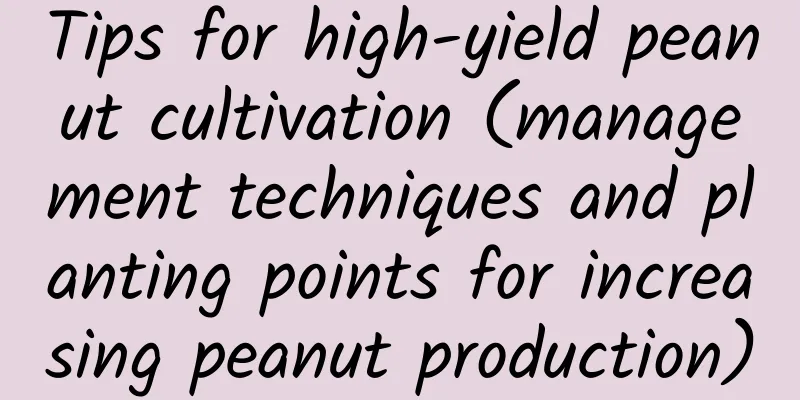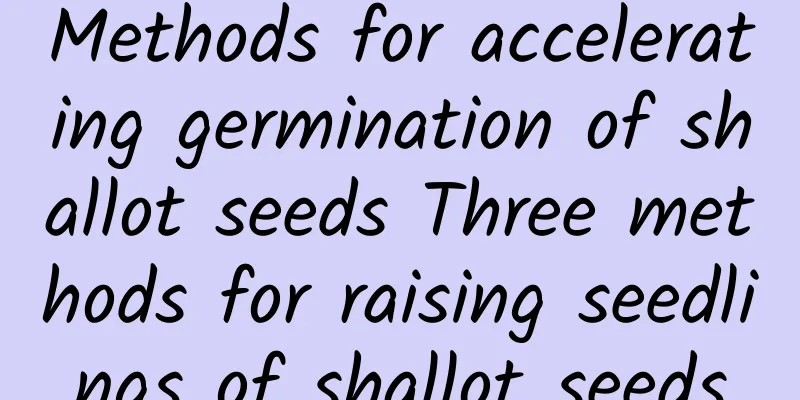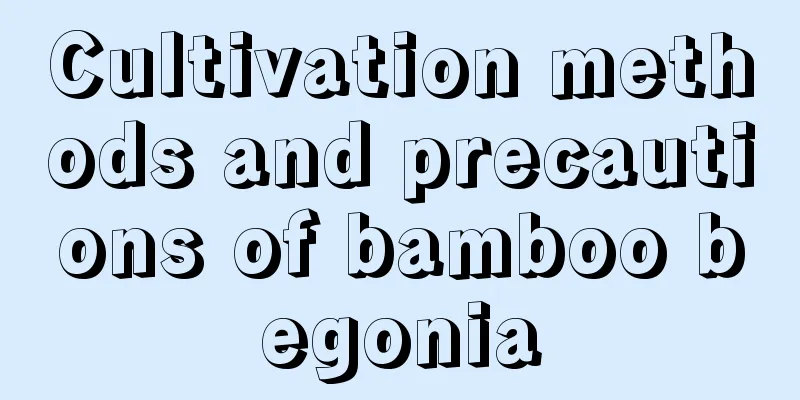Tips for high-yield peanut cultivation (management techniques and planting points for increasing peanut production)

|
Peanuts are the main crop grown on the thin land in the mountains here, without a doubt. After the peanut harvest every year, the sounds of "harvesting peanuts" can be heard one after another in the streets and alleys. Since a certain town in our city is known as the hometown of peanuts in China and is also a key cultivation project in the city, the peanuts here are relatively good in terms of both planting area and planting technology. Let's take spring peanuts as an example to briefly talk about the high-yield method. The first step is crop rotationPeanuts are very intolerant to repeated cropping. If they are planted for more than three years, the yield can be reduced by more than one third. Moreover, repeated cropping also leads to an unbalanced supply of soil pathogens and nutrients. The second step is to select good varietiesGood seeds produce good seedlings, and good seedlings mean half the harvest. Excellent peanut varieties are the basis for ensuring high yields. The third step is fertilization and ridge formationThis is one of the main cultivation measures for high yield of peanuts. Increasing the application of organic fertilizer can help to repair the soil, inhibit the occurrence of soil-borne diseases, improve the stress resistance of peanuts, and increase the yield. When using chemical fertilizers, pay attention to the coordinated application of nitrogen, phosphorus and potassium. In the middle and late stages of peanut growth, you can spray 0.2% potassium dihydrogen phosphate on the leaves 2-3 times, which is very beneficial for increasing yield. Peanut is a crop that requires a lot of calcium. For calcium-deficient acidic soil, you can increase the application of slaked lime, 30-50 kilograms per mu. For alkaline soil, you can increase the application of gypsum by 10-20 kilograms. Mix it with organic fertilizer and apply it as a base fertilizer. This can meet the calcium demand of the pod development period and increase the fruit fill rate. There are also many high-quality calcium fertilizers now, such as chelated calcium fertilizers, sugar alcohol calcium, etc. You can also spray them on the leaves during the initial flowering period and pod development period of peanuts, and you can spray them 2-3 times. High-quality calcium fertilizers such as chelated calcium and sugar alcohol calcium can be mixed with potassium dihydrogen phosphate and used immediately. It is not recommended to mix other calcium fertilizers, or you can try to see if any abnormal phenomena such as precipitation occur to determine whether they can be mixed. In addition, in the middle and late stages of peanut growth, 0.1%-0.2% ammonium molybdate or 0.05% boric acid solution can be used for foliar spraying, both of which have a good yield-increasing effect. Ridge-making and film-covering for peanut cultivation is a better measure and one of the important measures to increase production. Step 4: Mix seeds with chemicalsI have to emphasize this. In our area, due to continuous planting of peanuts for many years, peanut root rot, stem rot, and fruit rot are serious and occur over a large area. The phenomenon of seedling plants withering and dying is very serious, resulting in serious reduction in production and a great impact on fruit quality. In order to solve this problem, the town invited relevant experts to come up with a series of solutions, one of which is seed dressing, such as tebuconazole, fludioxonil, imidacloprid, fipronil, chlorantraniliprole, etc. Through the practice in recent years, it can be seen that the combination of Jingjia-fluanid + fipronil has two effects in one, which can prevent and control most diseases and pests of peanuts, such as root rot, fruit rot and other special diseases. At the same time, it improves the emergence rate, reduces seedling death and rot, makes the seedlings uniform and strong, and improves the yield and quality. Step 5: Control the growth and increase productionDuring the vigorous growth period of peanuts, due to the influence of external factors such as soil, water, fertilizer, variety, density, etc., it is easy for the peanut plants to grow too tall and fall over, resulting in reduced yield. I saw someone on TikTok introducing that if you step on the peanut vines and then cover them with a shovel of soil, you can increase the yield by so many kilograms. I laughed out loud after reading this. This is pure nonsense. Not to mention how hard it is to do this, just looking at the current peanut varieties, most of them are upright varieties. The key point in cultivation is to prevent lodging, otherwise it will result in reduced yield. It's fine if you step on it, but you also press down a shovel of soil. How are you going to harvest the peanuts then? That would be a lot of work and time. It's just like taking off your pants to fart. It's a thankless task. At present, in peanut production, we must pay attention to controlling growth and preventing lodging, which is one of the measures for high-yield management of peanuts. Do not step on the seedlings, and certainly do not press the soil after stepping them down. There are many drugs to control the excessive growth of peanuts, such as paclobutrazol, chlormequat, vinclozolin, and vinclozolin. I recommend you to use diniconazole, the dosage is easy to control, it is not easy to cause excessive growth control, and it will not cause soil residue like paclobutrazol. Step 6: Harvest at the right timePeanuts are a crop that blooms and bears fruit multiple times. The pods on the same plant mature at different times. If harvested too early, some pods will not be full, which directly affects the yield. If harvested too late, it is easy to cause the pods to fall off, increase rotten fruit, and even sprout. Therefore, timely harvesting is important. Generally speaking, when the top of the peanut no longer grows, most of the middle and lower leaves fall off, the top leaves turn yellow, and the leaves no longer close in the evening, when the plants are pulled out, more than 80% of the pods have clear reticular patterns. When peeling the pods, the seeds are full, the seed coat has the inherent color of the variety, such as dark red, and the inner membrane is black, which means it is time to harvest. In short, to achieve high yield of peanuts, attention should be paid to variety selection, seed mixing, soil, fertilizer and water management, strengthening disease and pest control, and timely and reasonable control to ensure high and stable yields . |
<<: What foliar fertilizer is best for corn?
>>: When is the best time to top the Kalanchoe (which month is the best time to top the Kalanchoe)
Recommend
What is a hedge? What does it do?
The role of hedges: to separate areas Whether wal...
Should you apply fertilizer first, then water, or first apply fertilizer and then water?
In the agricultural sector,...
The language and meaning of Casablanca flowers
The flower language of Lhasa Blanca There are sev...
What flowers are best for the bedroom to keep healthy (recommendations for plants that help with sleep and remove formaldehyde)
1. Clivia Don’t place potted plants that are too ...
The correct way to water green radish with beer
1. Dilute first. Watering directly will cause the...
What is the best fertilizer for green onions?
Fertilizing time for green onions Generally speak...
How many years does it take for passion fruit trees to bear fruit?
Introduction to Planting Passion Fruit Trees The ...
How to propagate glass begonias by cuttings and precautions How to propagate glass begonias by cuttings
Glass begonias are gorgeous when they bloom, and ...
How to grow kiwi fruit in pots
1. Potted Planting Method 1. Seed extraction: It ...
Can African jasmine be hydroponically cultivated? Hydroponics cutting methods and precautions
Can African jasmine be grown hydroponically? Afri...
What is the reason for tomato fruit cracking?
Tomato fruit cracking occurs when the tomato peel...
How to plant six times more seeds
1. Sowing time When sowing Hexapod seeds, you mus...
Can baby's breath be planted in the yard?
Can I plant baby's breath in the yard? Baby&#...
Orange cultivation methods and precautions
1. Maintenance methods 1. Substrate selection: Th...
The difference between hollow bubble and raspberry
Hollow bubble The hollow bubble is also known as ...









